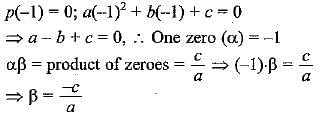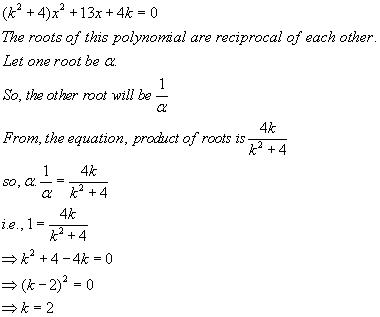All Exams >
Year 10 >
Mathematics for Year 10 >
All Questions
All questions of Polynomials for Year 10 Exam
Can you explain the answer of this question below: If α and β are the zeroes of the polynomial 5x2 – 7x + 2, then sum of their reciprocals is:- A:14/25
- B:7/5
- C:2/5
- D:7/2
The answer is d.
If α and β are the zeroes of the polynomial 5x2 – 7x + 2, then sum of their reciprocals is:
A:
14/25
B:
7/5
C:
2/5
D:
7/2

|
Anshu Shah answered |
We have 2 find (1/α + 1/β)
now 1/α + 1/β = (α + β)/ α β (taking LCM)
now by the given poly. we get
(α + β) = -b/a = 7/5
α β = c/a = 2/5
so, (α + β)/ α β = (7/5) / (2/5)
= 7/2
So, 1/α + 1/β = (α + β)/ α β = 7/2
Hence, 1/α + 1/β = 7/2
| 1 Crore+ students have signed up on EduRev. Have you? Download the App |
If one of the factors of x2 + x – 20 is (x + 5), then other factor is- a)(x – 4)
- b)(x – 5)
- c)(x – 6)
- d)(x – 7)
Correct answer is 'A'. Can you explain this answer?
If one of the factors of x2 + x – 20 is (x + 5), then other factor is
a)
(x – 4)
b)
(x – 5)
c)
(x – 6)
d)
(x – 7)
|
|
Arun Sharma answered |
Using mid-term splitting,
x2+x-20=x2+5x-4x-20=x(x+5)-4(x+5)
Taking common x+5
(x+5)(x-4) , so the other factor is x-4
x2+x-20=x2+5x-4x-20=x(x+5)-4(x+5)
Taking common x+5
(x+5)(x-4) , so the other factor is x-4
If the graph of a polynomial intersects the x – axis at three points, then the number of zeroes =- a)3
- b)0
- c)at most three
- d)at least three
Correct answer is option 'A'. Can you explain this answer?
If the graph of a polynomial intersects the x – axis at three points, then the number of zeroes =
a)
3
b)
0
c)
at most three
d)
at least three

|
Megha Roy answered |
If the graph of a polynomial intersects the x-axis at three points, then the number of zeroes are 3 because number of zeroes of the polynomial are the number of the coordinates of the points where its graph intersects the x-axis.
If p and q are the zeroes of the polynomial x2- 5x + k. Such that p - q = 1, find the value of K
- a)6
- b)7
- c)8
- d)9
Correct answer is option 'A'. Can you explain this answer?
If p and q are the zeroes of the polynomial x2- 5x + k. Such that p - q = 1, find the value of K
a)
6
b)
7
c)
8
d)
9
|
|
Leelu Bhai answered |
In the equation x² - 5x - k,
p + q = 5 and it is given that p - q = 1...
so, by solving, we get p = 3 and q = 2...
also, in this polynomial,...
pq = k ⇒ k = 3×2 = 6
p + q = 5 and it is given that p - q = 1...
so, by solving, we get p = 3 and q = 2...
also, in this polynomial,...
pq = k ⇒ k = 3×2 = 6
The zeros of the quadratic polynomial x2 + kx + k, k ≠ 0- a)both cannot be positive
- b)both cannot be negative
- c)are always equal
- d)are always unequal
Correct answer is option 'A'. Can you explain this answer?
The zeros of the quadratic polynomial x2 + kx + k, k ≠ 0
a)
both cannot be positive
b)
both cannot be negative
c)
are always equal
d)
are always unequal

|
Raghav. answered |
The zeros of a polynomial is not surely positive for any equation which is not specified...
If 3 + 5 – 8 = 0, then the value of (3)3 + (5)3 – (8)3 is- a)260
- b)–360
- c)–160
- d)160
Correct answer is option 'B'. Can you explain this answer?
If 3 + 5 – 8 = 0, then the value of (3)3 + (5)3 – (8)3 is
a)
260
b)
–360
c)
–160
d)
160
|
|
Anita Menon answered |
Given :
3 + 5 + (-8) = 0.
3 + 5 + (-8) = 0.
Then,
3³ + 5³ + (-8)³ = ?
3³ + 5³ + (-8)³ = ?
Using, identity...
If a+b+c=0, then a³ + b ³ + c³ = 3abc
If a+b+c=0, then a³ + b ³ + c³ = 3abc
Let a = 3, b = 5 and c = -8.
Here, a + b + c = 3 + 5 + (-8) = 0.
Then, a³ + b³ + c³ = 3³ + 5³ + (-8)³
= 3× 3 × 5 × -8
= 9 × -40
= -360
= 3× 3 × 5 × -8
= 9 × -40
= -360
The number of zeroes of a cubic polynomial is- a)3
- b)at least 3
- c)2
- d)at most 3
Correct answer is option 'D'. Can you explain this answer?
The number of zeroes of a cubic polynomial is
a)
3
b)
at least 3
c)
2
d)
at most 3
|
|
Nilima singh answered |
The number of zeroes of a cubic polynomial is at most 3 because the highest power of the variable in cubic polynomial is 3, i.e. ax3+bx2+cx+d
If 5 is a zero of the quadratic polynomial, (x^2) - kx - 15 then the value of k isa) 2b)-2c) 4d)- 4Correct answer is option 'A'. Can you explain this answer?- 4
If 5 is a zero of the quadratic polynomial, (x^2) - kx - 15 then the value of k is
a) 2
b)-2
c) 4
d)- 4
Correct answer is option 'A'. Can you explain this answer?
|
|
Rohit Sharma answered |
p(x) = x2- kx - 15
Given: p(5) = 0
⇒ (5)2- k(5) - 15 = 0
⇒ 25 - 5k - 15 = 0
⇒ 5k = 10
⇒ k = 10/5 = 2
⇒ (5)2- k(5) - 15 = 0
⇒ 25 - 5k - 15 = 0
⇒ 5k = 10
⇒ k = 10/5 = 2
Thus, Value of k is 2
What value/s can x take in the expression k(x – 10) (x + 10) =0 where k is any real number.- a)100, -100
- b)Infinitely many
- c)Depends on value of k
- d)10, -10
Correct answer is option 'D'. Can you explain this answer?
What value/s can x take in the expression k(x – 10) (x + 10) =0 where k is any real number.
a)
100, -100
b)
Infinitely many
c)
Depends on value of k
d)
10, -10
|
|
Avinash Patel answered |
k(x – 10) (x + 10) =0
⇒ either k=0
Or x-10=0
Or x+10=0
Since we don’t know the value of k
So either x-10=0
x=10
Or x+10=0
x=-10
So values of x can be 10,-10
⇒ either k=0
Or x-10=0
Or x+10=0
Since we don’t know the value of k
So either x-10=0
x=10
Or x+10=0
x=-10
So values of x can be 10,-10
If “1” is a zero of the polynomial P(a) = x2a2 – 2xa + 3x – 2 , then x = ______
- a)2
- b)-2, 1
- c)+2, -2
- d)-2, 0
Correct answer is option 'B'. Can you explain this answer?
If “1” is a zero of the polynomial P(a) = x2a2 – 2xa + 3x – 2 , then x = ______
a)
2
b)
-2, 1
c)
+2, -2
d)
-2, 0
|
|
Pooja Shah answered |
The correct solution of this question is given below:
Here, P(a) = x2a2 - 2xa + 3x - 2
1 is a zero of P(a), so P(1) = 0
Therefore, x212 - 2x.1 + 3x - 2 = 0
x2 + x - 2 = 0
(x + 2)(x - 1) = 0
x = -2, 1
The real number which should be subtracted from the polynomial 2x3+5x2−14x+10 so that the polynomial 2x−3 divides it exactly is
- a)7
- b)– 6
- c)6
- d)– 7
Correct answer is option 'A'. Can you explain this answer?
The real number which should be subtracted from the polynomial 2x3+5x2−14x+10 so that the polynomial 2x−3 divides it exactly is
a)
7
b)
– 6
c)
6
d)
– 7
|
|
Arun Sharma answered |
Polynomial is formed composed of the phrases Nominal, which means "terms," and Poly, which means "many." When exponents, constants, and variables are combined using mathematical operations like addition, subtraction, multiplication, and division, the result is a polynomial (No division operation by a variable). The classification of the phrase as a monomial, binomial, or trinomial depends on how many terms are included in it. Here are some examples of constants, variables, and exponents:
Constants. For instance, 1, 2, 3, etc.
Variables. For instance, g, h, x, y, etc.
Exponents: For instance, "5 in x5"
Given:
Find:
To find the real number which should be subtracted from the given polynomial.
Solution:
Hence 7 should be subtracted so that the polynomial  is exactly divisible by
is exactly divisible by 
Therefore, 7 should be subtracted.
A polynomial of degree three is called ……- a)cubic polynomial
- b)quadratic polynomial
- c)linear polynomial
- d)zero polynomial
Correct answer is option 'A'. Can you explain this answer?
A polynomial of degree three is called ……
a)
cubic polynomial
b)
quadratic polynomial
c)
linear polynomial
d)
zero polynomial

|
Maitri Kulkarni answered |
A cubic polynomial is a polynomial of the form  . A cubic polynomial is a polynomial of degree 3. A univariate cubic polynomial has the form . An equation involving a cubic polynomial is called a cubic equation. A closed-form solution known as the cubic formula exists for the solutions of an arbitrary cubic equation.
. A cubic polynomial is a polynomial of degree 3. A univariate cubic polynomial has the form . An equation involving a cubic polynomial is called a cubic equation. A closed-form solution known as the cubic formula exists for the solutions of an arbitrary cubic equation.
 . A cubic polynomial is a polynomial of degree 3. A univariate cubic polynomial has the form . An equation involving a cubic polynomial is called a cubic equation. A closed-form solution known as the cubic formula exists for the solutions of an arbitrary cubic equation.
. A cubic polynomial is a polynomial of degree 3. A univariate cubic polynomial has the form . An equation involving a cubic polynomial is called a cubic equation. A closed-form solution known as the cubic formula exists for the solutions of an arbitrary cubic equation.The zero of the polynomial p(x) = 2x + 5 is- a)2
- b)5
- c)2/5
- d)-5/2
Correct answer is option 'D'. Can you explain this answer?
The zero of the polynomial p(x) = 2x + 5 is
a)
2
b)
5
c)
2/5
d)
-5/2
|
|
Pooja Shah answered |
Given, p(x) = 2x+5
For zero of the polynomial, put p(x) = 0
⇒ 2x + 5 = 0
⇒ x = -5/2
For zero of the polynomial, put p(x) = 0
⇒ 2x + 5 = 0
⇒ x = -5/2
Thus, zero of the polynomial p(x) is -5/2.
If one of the zeroes of the cubic polynomial x3−7x+6 is 2, then the product of the other two zeroes is- a)2
- b)3
- c)– 3
- d)– 2
Correct answer is 'C'. Can you explain this answer?
If one of the zeroes of the cubic polynomial x3−7x+6 is 2, then the product of the other two zeroes is
a)
2
b)
3
c)
– 3
d)
– 2

|
Navya Patel answered |
Let α,β,γ are the zeroes of the given polynomial. Given: α = 2
Since αβγ = -d/a
Since αβγ = -d/a
On dividing x3 – 3x2 + x + 2 by polynomial g(x), the quotient and remainder were x – 2 and 4 – 2x respectively
then g(x) :- a)x2 + x + 1
- b)x2 + x – 1
- c)x2 – x – 1
- d)x2 – x + 1
Correct answer is option 'D'. Can you explain this answer?
On dividing x3 – 3x2 + x + 2 by polynomial g(x), the quotient and remainder were x – 2 and 4 – 2x respectively
then g(x) :
then g(x) :
a)
x2 + x + 1
b)
x2 + x – 1
c)
x2 – x – 1
d)
x2 – x + 1
|
|
Ananya Das answered |
We have remainder theorem as
x3-3x2+x+2=q(x)*g(x)+r(x)
x3-3x2+x+2=(x-2)g(x)+(4-2x)
g(x)=
So by division method,
g(x)= x2 - x + 1
x3-3x2+x+2=q(x)*g(x)+r(x)
x3-3x2+x+2=(x-2)g(x)+(4-2x)
g(x)=

So by division method,
g(x)= x2 - x + 1
A polynomial of degree ____ is called a quadratic polynomial.- a)0
- b)2
- c)1
- d)3
Correct answer is option 'B'. Can you explain this answer?
A polynomial of degree ____ is called a quadratic polynomial.
a)
0
b)
2
c)
1
d)
3

|
Abhiram Gupta answered |
A polynomial of degree 2 is called a quadratic polynomial.
If α,β be the zeros of the quadratic polynomial 2 – 3x – x2, then α + β =- a)2
- b)3
- c)1
- d)None of these
Correct answer is option 'D'. Can you explain this answer?
If α,β be the zeros of the quadratic polynomial 2 – 3x – x2, then α + β =
a)
2
b)
3
c)
1
d)
None of these
|
|
Pooja Shah answered |
If α and β are the zeros of the polynomial then
(x−α)(x−β) are the factors of the polynomial
Thus, (x−α)(x−β) is the polynomial.
So, the polynomial =x2 − αx − βx + αβ
=x2 − (α + β)x + αβ....(i)
Now,the quadratic polynomial is
2 − 3x − x2 = x2 + 3x − 2....(ii)
(x−α)(x−β) are the factors of the polynomial
Thus, (x−α)(x−β) is the polynomial.
So, the polynomial =x2 − αx − βx + αβ
=x2 − (α + β)x + αβ....(i)
Now,the quadratic polynomial is
2 − 3x − x2 = x2 + 3x − 2....(ii)
Now, comparing equation (i) and (ii),we get,
−(α + β) = 3
α + β = −3
−(α + β) = 3
α + β = −3
If α,β are the zeros of x2 + px + 1 and γ,δ be those of x2 + qx + 1, then the value of (α–γ) (β–γ) (α+δ) (β+δ) = [DCE-2000]- a)p2 – q2
- b)q2 – p2
- c)p2
- d)q2
Correct answer is option 'B'. Can you explain this answer?
If α,β are the zeros of x2 + px + 1 and γ,δ be those of x2 + qx + 1, then the value of (α–γ) (β–γ) (α+δ) (β+δ) = [DCE-2000]
a)
p2 – q2
b)
q2 – p2
c)
p2
d)
q2
|
|
Gaurav Kumar answered |
Alpha(a) and beta(b) are roots of x^2 + px + 1
This implies that sum of roots= a+b = -p/1=-p
And the product of roots = ab = 1/1=1
Similarly ,
Gamma(c) and delta(d) are roots of x^2 + qx + 1
So c+d=-q and cd =1.
The above results can be obtained once we know that any quadratic equation has two roots and hence can be written as (x-p)(x-q)=0 where a and b are the roots .
So x^2 -(p+q)x + pq =0
Comparing this with the general form of quadratic equation :ax^2 + bx + c= 0 we get
Sum of the roots =p+q= -b/a
And product of the roots = pq = c/a}
RHS=(a-c)(b-c)(a+d)(b+d)
=(c^2-ac-bc +ab)(d^2 +bd +ad + ab)
We know ab=1
So RHS= (c^2-ac-bc +1)(d^2 +bd +ad + 1)
= (c^2)(d^2) +(a+b)c^2(d) + c^2 -(d^2)c(a+b) -(a+b)^2(cd) -(a+b)c + d^2 + bd + ad + 1
= 1 + ac+bc + c^2 - da-db - (a^2 + b^2 + 2(1)) -ac -bc + bd + ad +1
Cancelling off all the common terms,
We get c^2 +d^2-a^2-b^2
= c^2+d^2-a^2-b^2
=c^2 -a^2 + d^2 -b^2 + 2(1) -2(1){ ab=cd =1}
=c^2 + d^2 + 2cd - a^2 - b^2 - 2ab
LHS=(c+d)^2-(a+b)^2
Therefore,
But we know -p= a+b and -q = c+d
LHS= q^2-p^2
= c^2+d^2-a^2-b^2
=c^2 -a^2 + d^2 -b^2 + 2(1) -2(1){ ab=cd =1}
=c^2 + d^2 + 2cd - a^2 - b^2 - 2ab
LHS=(c+d)^2-(a+b)^2
Therefore,
But we know -p= a+b and -q = c+d
LHS= q^2-p^2
If the zeroes of the quadratic polynomial x2 + (a + 1) x + b are 2 and -3, the- a)a = -7, b = -1
- b)a = 5, b = -1
- c)a = 2, b = -6
- d)a = 0, b = -6
Correct answer is option 'D'. Can you explain this answer?
If the zeroes of the quadratic polynomial x2 + (a + 1) x + b are 2 and -3, the
a)
a = -7, b = -1
b)
a = 5, b = -1
c)
a = 2, b = -6
d)
a = 0, b = -6
|
|
Amit Sharma answered |
p(x) = x2 + (a + 1)x + b
Given: zeros of polynomial is 2, -3
For x = 2
(2)2 + (a + 1)2 + b = 0
⇒ 4 + 2a + 2 + b = 0
⇒ 2a + b = -6 ...(i)
Given: zeros of polynomial is 2, -3
For x = 2
(2)2 + (a + 1)2 + b = 0
⇒ 4 + 2a + 2 + b = 0
⇒ 2a + b = -6 ...(i)
For x = -3
(-3)2 + (a + 1) (-3) + b = 0
⇒ 9 - 3a - 3 + b = 0
⇒ -3a + b = -6 ..(ii)
(-3)2 + (a + 1) (-3) + b = 0
⇒ 9 - 3a - 3 + b = 0
⇒ -3a + b = -6 ..(ii)
Solving (i) and (ii), we get 5a = 0
⇒ a = 0 and b = -6
⇒ a = 0 and b = -6
Alternative method:
p(x) = x2 + (a + 1)x + b
Given: zeros of polynomial is 2, -3
Given: zeros of polynomial is 2, -3
Sum of zeros: -(a+1) = 2-3
⇒ a = 0
Product of zeros: b = 2.(-3) = -6
⇒ a = 0
Product of zeros: b = 2.(-3) = -6
If α and β are the zeros of the polynomial f(x) = 15x2 – 5x + 6 then 
 is equal to –
is equal to –- a)13/3
- b)13/2
- c)16/3
- d)15/2
Correct answer is option 'A'. Can you explain this answer?
If α and β are the zeros of the polynomial f(x) = 15x2 – 5x + 6 then 
 is equal to –
is equal to –
a)
13/3
b)
13/2
c)
16/3
d)
15/2
|
|
Anita Menon answered |
The correct answer is a.
(1+1/α) (1+1/β)
= (α+1/α) (β+1/β)
=αβ + α + β + 1 / αβ
=( 2/5 + 1/3+ 1) / 2/5
=26/15 X 5/2 = 13/3
Quadratic polynomial having sum of it's zeros 5 and product of it's zeros – 14 is –- a)x2 – 5x – 14
- b)x2 – 10x – 14
- c)x2 – 5x + 14
- d)None of these
Correct answer is option 'A'. Can you explain this answer?
Quadratic polynomial having sum of it's zeros 5 and product of it's zeros – 14 is –
a)
x2 – 5x – 14
b)
x2 – 10x – 14
c)
x2 – 5x + 14
d)
None of these
|
|
Amit Kumar answered |
The quadratic equation is of the form x2 - (sum of zeros) x + (product of zeros)
=x2 - 5x - 14
=x2 - 5x - 14
If the polynomial 3x2 – x3 – 3x + 5 is divided by another polynomial x – 1 – x2, the remainder comes out to be 3, then quotient polynomial is –
- a)2 – x
- b)2x – 1
- c)3x + 4
- d)x - 2
Correct answer is option 'D'. Can you explain this answer?
If the polynomial 3x2 – x3 – 3x + 5 is divided by another polynomial x – 1 – x2, the remainder comes out to be 3, then quotient polynomial is –
a)
2 – x
b)
2x – 1
c)
3x + 4
d)
x - 2

|
Nidhi Godhani answered |
Let's assume the quotient polynomial as ax + b.
Now, (x - 1 - x^2)(ax + b) + 3 = 3x^2 - x^3 - 3x + 5
ax^3 + bx^2 + ax^2 - ax^2 - bx - a + 3 = -x^3 + 3x^2 - 3x + 5
ax^3 + (b - 1)x^2 + (a - b)x + (3 - a) = -x^3 + 3x^2 - 3x + 5
Equating the coefficients of the same degree terms on both sides, we get:
For x^3: a = -1 For x^2: b - 1 = 3 => b = 4 For x: a - b = -3 => a - 4 = -3 => a = 1 For constant: 3 - a = 5 => a = -2
Therefore, the quotient polynomial is x + 4.
Hence, the quotient polynomial is x + 4.
The quadratic polynomial whose zeros are twice the zeros of 2x2 – 5x + 2 = 0 is – [Kerala Engineering-2003]- a)8x2 – 10x + 2
- b)x2 – 5x + 4
- c)2x2 – 5x + 2
- d)x2 – 10x + 6
Correct answer is option 'B'. Can you explain this answer?
The quadratic polynomial whose zeros are twice the zeros of 2x2 – 5x + 2 = 0 is – [Kerala Engineering-2003]
a)
8x2 – 10x + 2
b)
x2 – 5x + 4
c)
2x2 – 5x + 2
d)
x2 – 10x + 6
|
|
Lakshay pandey answered |
Let α and β be the roots of the given equation.
Then, α + β = 5/2 and αβ = 2/2 = 1
∴ 2α + 2β
∴ 2(α + β)
∴ 5,(2α)(2β) = 4
So, the requiared equation is :
x2−5x+4=0
Then, α + β = 5/2 and αβ = 2/2 = 1
∴ 2α + 2β
∴ 2(α + β)
∴ 5,(2α)(2β) = 4
So, the requiared equation is :
x2−5x+4=0
If one root of the polynomial x2 + px + q is square of the other root, then – [IIT-Screening-2004]- a)p3 – q (3p – 1) + q2 = 0
- b)p3 – q (3p + 1) + q2 = 0
- c)p3 + q (3p – 1) – q2 = 0
- d)p3 + q (3p + 1) – q2 = 0
Correct answer is option 'A'. Can you explain this answer?
If one root of the polynomial x2 + px + q is square of the other root, then – [IIT-Screening-2004]
a)
p3 – q (3p – 1) + q2 = 0
b)
p3 – q (3p + 1) + q2 = 0
c)
p3 + q (3p – 1) – q2 = 0
d)
p3 + q (3p + 1) – q2 = 0
|
|
Amit Sharma answered |
Let one root be a, other root is a2.
(x-a)(x-a2)=x2+(-a2-a)x+a3
p3=(-a2-a)3=-a6-3a5-3a4-a3
-q(3p-1)= -a3(3(-a2-a)-1)=3a5+3a4+a3
q2=a6
Substituting the values
-a6-3a5-3a4-a3+3a5+3a4+a3+a6=0
(x-a)(x-a2)=x2+(-a2-a)x+a3
p3=(-a2-a)3=-a6-3a5-3a4-a3
-q(3p-1)= -a3(3(-a2-a)-1)=3a5+3a4+a3
q2=a6
Substituting the values
-a6-3a5-3a4-a3+3a5+3a4+a3+a6=0
If one root of the polynomial p(y) = 5y2 + 13y + m is reciprocal of other, then the value of m is- a)6
- b)0
- c)5
- d)1/5
Correct answer is option 'C'. Can you explain this answer?
If one root of the polynomial p(y) = 5y2 + 13y + m is reciprocal of other, then the value of m is
a)
6
b)
0
c)
5
d)
1/5
|
|
Vivek Rana answered |
Let the roots be α and 1/α.
Product of roots = α(1/α) = 1
⇒ m/5 = 1
⇒ m = 5
⇒ m/5 = 1
⇒ m = 5
If one of the zeros of a quadratic polynomial of the form x2 + ax + b is the negative of the other, then it- a)has no linear term and the constant term is negative
- b)has no linear term and the constant term is positive
- c)can have a linear term but the constant term is negative
- d)can have a linear term but the constant term is positive
Correct answer is option 'A'. Can you explain this answer?
If one of the zeros of a quadratic polynomial of the form x2 + ax + b is the negative of the other, then it
a)
has no linear term and the constant term is negative
b)
has no linear term and the constant term is positive
c)
can have a linear term but the constant term is negative
d)
can have a linear term but the constant term is positive
|
|
Anita Menon answered |
Let p(x) = x2 + ax + b.
Put a = 0 then, p(x) = x2 + b = 0
⇒ x2 = -b
⇒ x = ±√-b [∴ b < 0]
Hence, if one of the zeroes of quadratic polynomial p(x) is the negative of the other,
then it has no linear term i.e., a = 0 and the constant term is negative i.e., b< 0.
Put a = 0 then, p(x) = x2 + b = 0
⇒ x2 = -b
⇒ x = ±√-b [∴ b < 0]
Hence, if one of the zeroes of quadratic polynomial p(x) is the negative of the other,
then it has no linear term i.e., a = 0 and the constant term is negative i.e., b< 0.
Alternate Method
Let f(x) = x2 + ax+ b
Given condition the zeroes are α and – α.
Sum of the zeroes (-a) = α - α = 0
Product of zeroes (b) = α .(- α) = - α2
Hence, it has no linear term and the constant term is negative.
Let f(x) = x2 + ax+ b
Given condition the zeroes are α and – α.
Sum of the zeroes (-a) = α - α = 0
Product of zeroes (b) = α .(- α) = - α2
Hence, it has no linear term and the constant term is negative.
A quadratic polynomial, whose zeros are 5 and - 8 is
- a)x2 + 13x - 40
- b)x2 + 4x - 3
- c)x2 - 3x + 40
- d)x2 + 3x - 40
Correct answer is option 'D'. Can you explain this answer?
A quadratic polynomial, whose zeros are 5 and - 8 is
a)
x2 + 13x - 40
b)
x2 + 4x - 3
c)
x2 - 3x + 40
d)
x2 + 3x - 40
|
|
Kuldeep Raj answered |

Learn important definitions and formulas of Quadratic Equations by going through the doc:
If the sum of the two zeros of x3 + px2 +qx + r is zero, then pq =- a)– r
- b)r
- c)2r
- d)– 2r
Correct answer is option 'B'. Can you explain this answer?
If the sum of the two zeros of x3 + px2 +qx + r is zero, then pq =
a)
– r
b)
r
c)
2r
d)
– 2r
|
|
Amit Kumar answered |
Sum of two solutions is zero ,so both are inverse of each other. So we have the solutions as a,-a,b.
(x-a)(x+a)(x+b)=(x2-a2)(x+b)=x3+bx2-a2x-a2b
pq=-a2b=r
(x-a)(x+a)(x+b)=(x2-a2)(x+b)=x3+bx2-a2x-a2b
pq=-a2b=r
Can you explain the answer of this question below:The sum of two zeroes of the polynomial f(x) = 2x2+(p+3) x+5 is zero, then the value of ‘p’ is
- A:
4
- B:
– 4
- C:
3
- D:
– 3
The answer is d.
The sum of two zeroes of the polynomial f(x) = 2x2+(p+3) x+5 is zero, then the value of ‘p’ is
4
– 4
3
– 3

|
Shubham Mukherjee answered |
Let one zeroes of the given polynomial be α and β. According to the question,

Which of the following is not the graph of a quadratic polynomial ?- a)
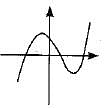
- b)
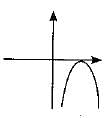
- c)
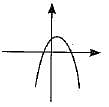
- d)
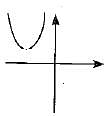
Correct answer is option 'A'. Can you explain this answer?
Which of the following is not the graph of a quadratic polynomial ?
a)

b)

c)

d)

|
|
Vikram Kapoor answered |
For any quadratic polynomial ax2 + bx + c, a≠0, graph for the corresponding equation:
- Has one of the two shapes either open upwards like ∪ or open downwards like ∩ depending on whether a > 0 or a < 0. These curves are called parabolas.
- The curve of a quadratic polynomial crosses the X-axis on at most two points.
Thus, option A is correct.
The number of polynomials having zeros as - 2 and 5 is- a)1
- b)2
- c)3
- d)more than 3
Correct answer is option 'D'. Can you explain this answer?
The number of polynomials having zeros as - 2 and 5 is
a)
1
b)
2
c)
3
d)
more than 3

|
Shubham Mukherjee answered |
let - 2 and 5 are the zeroes of the polynomials of the formp(x) = ax^2 + bx + c.
sum of the zeroes = - (coefficient of x) � coefficient of x^2 i.e.
Sum of the zeroes = - b/a
- 2 + 5 = - b/a
3 = - b/a
⇒ b = - 3 and a = 1
Product of the zeroes = constant term � coefficient of x^2 i.e.
Product of zeroes = c/a
(- 2)5 = c/a
- 10 = c
Put the values of a, b and c in the polynomial p(x) = ax^2 + bx + c.
∴ The equation is x^2 - 3x - 10
OR
The equation of a quadratic polynomial is given by x^2 - (sum of the zeroes)x + (product of the zeroes) where,
Sum of the zeroes = - (coefficient of x) � coefficient of x^2 and
Product of the zeroes = constant term � coefficient of x^2
∴ Sum of the zeroes = - 2 + 5 and product of the zeroes = (- 2)5
= 3 = - 10
∴ the equation is x^2 - 3x - 10
We know, the zeroes do not change if the polynomial is divided or multiplied by a constant
⇒ kx^2 - 3kx - 10k will also have - 2 and 5 as their zeroes.
As k can take any real value, there can be many polynomials having - 2 and 5 as their zeroes.
Which one of the following statements is correct- a)if x6 + 1 is divided by x +1, then the remainder is -2
- b)if x6 + 1 is divided by x - 1, then the remainder is 2
- c)if x6 + 1 is divided by x + 1 , then the remainder is 1
- d)if x6 + 1 is divided by x - 1, then the remainder is -1
Correct answer is option 'B'. Can you explain this answer?
Which one of the following statements is correct
a)
if x6 + 1 is divided by x +1, then the remainder is -2
b)
if x6 + 1 is divided by x - 1, then the remainder is 2
c)
if x6 + 1 is divided by x + 1 , then the remainder is 1
d)
if x6 + 1 is divided by x - 1, then the remainder is -1
|
|
Jai kamat answered |
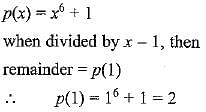
If x = 2 and x = 3 are zeros of the quadratic polynomial x2 + ax + b, the values of a and b respectively are :- a)5, 6
- b)- 5, - 6
- c)- 5, 6
- d)5, - 6
Correct answer is option 'C'. Can you explain this answer?
If x = 2 and x = 3 are zeros of the quadratic polynomial x2 + ax + b, the values of a and b respectively are :
a)
5, 6
b)
- 5, - 6
c)
- 5, 6
d)
5, - 6
|
|
Gaurav Kumar answered |
Zeros of the polynomials are the values which gives zero when their value is substituted in the polynomial
When x=2,
x2+ax+b =(2)2+a*2+b=0
4+2a+b=0
b=-4-2a ….1
When x=3,
(3)2+ 3a + b=0
9 + 3a + b=0
Substituting
9 + 3a - 4 - 2a =0
5 + a =0
a = -5
b = 6
When x=2,
x2+ax+b =(2)2+a*2+b=0
4+2a+b=0
b=-4-2a ….1
When x=3,
(3)2+ 3a + b=0
9 + 3a + b=0
Substituting
9 + 3a - 4 - 2a =0
5 + a =0
a = -5
b = 6
If 4x2 - 6x - m is divisible by x - 3, the value of m is exact divisor of
- a)36
- b)45
- c)20
- d)9
Correct answer is option 'A'. Can you explain this answer?
If 4x2 - 6x - m is divisible by x - 3, the value of m is exact divisor of
a)
36
b)
45
c)
20
d)
9
|
|
Rohit Sharma answered |
Here p(3) = 0
⇒ 4(3)2 - 6 x 3 - m = 0
⇒ 36 - 18 - m = 0 ⇒ m =18
∴ Value of m is exact divisior of 36.
⇒ 4(3)2 - 6 x 3 - m = 0
⇒ 36 - 18 - m = 0 ⇒ m =18
∴ Value of m is exact divisior of 36.
If one of the zeroes of the quadratic polynomial (k - 1)x2 + kx + 1 is -3, then the value of k is- a)4/3
- b)-4/3
- c)2/3
- d)-2/3
Correct answer is option 'A'. Can you explain this answer?
If one of the zeroes of the quadratic polynomial (k - 1)x2 + kx + 1 is -3, then the value of k is
a)
4/3
b)
-4/3
c)
2/3
d)
-2/3
|
|
Ananya Das answered |
p(x) = (k - 1)x2 + kx +1
One zero of polynomial is - 3 i.e. p(-3) = 0
⇒ (k - 1) (-3)2 + k(-3) + 1 = 0
⇒ 9k - 9 - 3k + 1 = 0
⇒ 6k - 8 = 0
⇒ k = 8/6 = 4/3
⇒ (k - 1) (-3)2 + k(-3) + 1 = 0
⇒ 9k - 9 - 3k + 1 = 0
⇒ 6k - 8 = 0
⇒ k = 8/6 = 4/3
The number of polynomials having zeroes -2 and 5 is:- a)1
- b)3
- c)2
- d)more than 3
Correct answer is option 'D'. Can you explain this answer?
The number of polynomials having zeroes -2 and 5 is:
a)
1
b)
3
c)
2
d)
more than 3
|
|
Amit Kumar answered |
Since the question doesn’t say that there are only 2 zeros of the polynomial we , there can be n number of polynomials which have two of its zeros as -2 and 5 .So the correct answer is more than 3.
The quadratic polynomial whose sum of zeroes is 3 and product of zeroes is –2 is :- a) x2 + 3x – 2
- b)x2 – 2x + 3
- c)x2 – 3x + 2
- d)x2 – 3x – 2
Correct answer is 'C'. Can you explain this answer?
The quadratic polynomial whose sum of zeroes is 3 and product of zeroes is –2 is :
a)
x2 + 3x – 2
b)
x2 – 2x + 3
c)
x2 – 3x + 2
d)
x2 – 3x – 2
|
|
Pooja Shah answered |
Sum of zeros = 3/1
-b/a = 3/1
Product of zeros = 2/1
c/a = 2/1
This gives
a = 1
b = -3
c = -2,
The required quadratic equation is
ax2+bx+c
So, x2-3x+2
-b/a = 3/1
Product of zeros = 2/1
c/a = 2/1
This gives
a = 1
b = -3
c = -2,
The required quadratic equation is
ax2+bx+c
So, x2-3x+2
If p(x) is a polynomial of at least degree one and p(k) = 0, then k is known as- a)value of p(x)
- b)zero of p(x)
- c)constant term of p(x)
- d)none of these
Correct answer is option 'B'. Can you explain this answer?
If p(x) is a polynomial of at least degree one and p(k) = 0, then k is known as
a)
value of p(x)
b)
zero of p(x)
c)
constant term of p(x)
d)
none of these
|
|
Ishan Choudhury answered |
Let p(x) = ax + b
p(k) = ak + b = 0
∴ k is zero of p(x)
p(k) = ak + b = 0
∴ k is zero of p(x)
The graph of the quadratic polynomial ax2 + bx + c, a ≡ 0 is always –- a)Straight line
- b)Curve
- c)Parabola
- d)None of these
Correct answer is option 'C'. Can you explain this answer?
The graph of the quadratic polynomial ax2 + bx + c, a ≡ 0 is always –
a)
Straight line
b)
Curve
c)
Parabola
d)
None of these
|
|
Anita Menon answered |
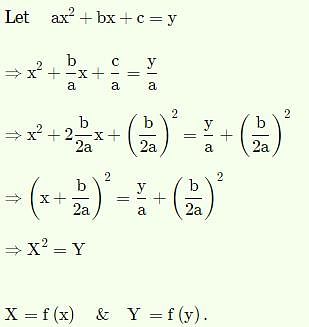
So it s an equation of a parabola.
The graph will be that of a parabola.
Find the sum and the product of the zeroes of the polynomial: x2-3x-10- a)3, 10
- b)-3, -10
- c)3,-10
- d)-3, 10
Correct answer is option 'C'. Can you explain this answer?
Find the sum and the product of the zeroes of the polynomial: x2-3x-10
a)
3, 10
b)
-3, -10
c)
3,-10
d)
-3, 10
|
|
Raghav Bansal answered |
X²-3x-10
x² -(5x-2x)-10
x² - 5x+2x-10
x(x-5)+2(x-5)
(x-5)(x+2)
x=5
x=-2
Sum of zeroes = α+β = 5-2 = 3
α+β = -b/a = -(-3)/1 = 3
Product of zeroes = αβ = 5*-2 = -10
αβ = c/a = -10/1 = -10
x² -(5x-2x)-10
x² - 5x+2x-10
x(x-5)+2(x-5)
(x-5)(x+2)
x=5
x=-2
Sum of zeroes = α+β = 5-2 = 3
α+β = -b/a = -(-3)/1 = 3
Product of zeroes = αβ = 5*-2 = -10
αβ = c/a = -10/1 = -10
If one zero of the quadratic polynomial x2+ 3x + k is 2, then the value of ‘k’ is- a)– 10
- b)5
- c)– 5
- d)10
Correct answer is option 'A'. Can you explain this answer?
If one zero of the quadratic polynomial x2+ 3x + k is 2, then the value of ‘k’ is
a)
– 10
b)
5
c)
– 5
d)
10
|
|
Rajiv Gupta answered |
Let the given quadratic polynomial be p(x) = x^2 + 3x + k
Given one of the zero of the quadratic polynomial is 2.
Hence p(2) = 0
Put x = 2 in p(x), we get
p(2) = 2^2 + 3(2) + k
⇒ 0 = 4 + 6 + k
⇒ 0 = 10 + k
∴ k = – 10
Find the quadratic polynomial whose zeros are 2 and -6
- a)x2 + 4x + 12
- b)x2 – 4x – 12
- c)x2 + 4x – 12
- d)x2 – 4x + 12
Correct answer is option 'C'. Can you explain this answer?
Find the quadratic polynomial whose zeros are 2 and -6
a)
x2 + 4x + 12
b)
x2 – 4x – 12
c)
x2 + 4x – 12
d)
x2 – 4x + 12
|
|
Naina Sharma answered |
We know that quadratic equation is of the form x2-(sum of zeros)x+product of zeros
Sum of zeros=2-6=-4
Product of zeros=2*(-6)=-12
x2-(sum of roots )x + product of roots
x2-(-4)x + 12
x2+4x-12
So the equation is x2+4x-12
Sum of zeros=2-6=-4
Product of zeros=2*(-6)=-12
x2-(sum of roots )x + product of roots
x2-(-4)x + 12
x2+4x-12
So the equation is x2+4x-12
Chapter doubts & questions for Polynomials - Mathematics for Year 10 2024 is part of Year 10 exam preparation. The chapters have been prepared according to the Year 10 exam syllabus. The Chapter doubts & questions, notes, tests & MCQs are made for Year 10 2024 Exam. Find important definitions, questions, notes, meanings, examples, exercises, MCQs and online tests here.
Chapter doubts & questions of Polynomials - Mathematics for Year 10 in English & Hindi are available as part of Year 10 exam.
Download more important topics, notes, lectures and mock test series for Year 10 Exam by signing up for free.
Mathematics for Year 10
101 videos|327 docs|113 tests
|
Signup to see your scores go up within 7 days!
Study with 1000+ FREE Docs, Videos & Tests
10M+ students study on EduRev
|
Free Exam Preparation
at your Fingertips!
Access Free Study Material - Test Series, Structured Courses, Free Videos & Study Notes and Prepare for Your Exam With Ease

 Join the 10M+ students on EduRev
Join the 10M+ students on EduRev
|

|
Forgot Password
OR
Signup to see your scores
go up within 7 days!
Access 1000+ FREE Docs, Videos and Tests
Takes less than 10 seconds to signup






